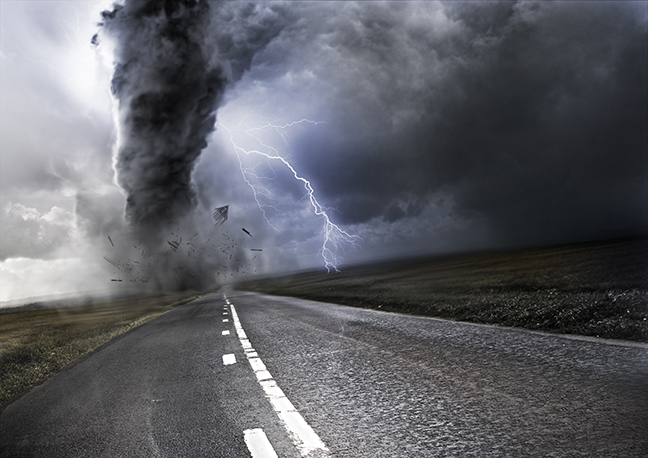
Last month, we heard how disaster struck while Andrew was on a trip. A tornado came through Andrew’s hometown and tore the gable off his roof and did some additional exterior and interior damage. We hear how he was told, and how he had to focus on the task at hand. This month, we discuss the steps you should be aware of and take if you find yourself in a similar situation.
Sitting in the airplane prior to pushback, I’m staring at my airline’s weather program and watching a line of small storms quickly zoom through my neighborhood back home. My captain’s momentary expletive-riddled statement broke my gaze. “Oh sorry, this isn’t heading our way, it’s Chicago,” was my response when I saw the concern on his face. His reaction was understandable, given our flight was departing New York’s airspace, and any cloud within 1000 miles threatens to ruin everyone’s day. But this line of weather didn’t look to be too terrible for the Midwest in the middle of the summer.
The radar returns were orange at their most intense, and only flashed periods of red during the storm’s march across the Chicago suburbs. When I selected the radar summary function on my weather app, the top of the precipitation was showing only between 30,000´ and 35,000´. Certainly not the supercell thunderstorms that normally drop tornados, or even hail for that matter. There was no indication on the app that there was any rotation in the cells either. How could anything have been wrong, and why wasn’t I getting any responses from back home?
Of the 13 tornados confirmed on July 12th, all were either EF-0 or EF-1 which means the winds varied between 65 mph and 110 mph. So much for the weather app being accurate. Even the smallest of tornados, an EF-0, can make life complicated if your house takes a direct hit. If you read last month’s article, the pictures showed that my house was clearly in the wrong place at the wrong time, which is made even more impressive by the fact that it was quite literally the only house to be hit on the block!
Imagine stepping out of your house after a tornado strike, thankful you and your family are alive and well, and you head to the side of your house and see a similar scene as the one depicted in my photo. Now, without looking at your phone (and don’t read ahead!), what are the steps to take care of?
Most people would probably think of calling their insurance agent first to get the claim started, and you wouldn’t be far off! Unfortunately, if you make this your first step, you may miss some very critical safety steps that can reduce your risk of further damage. I propose the following steps, in as close to order as possible:
- Triage you and your family’s injuries: This is obvious, but make sure no one in your family is injured. Shock and adrenaline can mask an amazing amount of trauma, and sometimes people don’t realize they are hurt until getting medical attention becomes critical.
- Clear your home: Assuming the weather has passed, exit your home quickly and safely. Do not re-enter your home unless there is an absolute need to do so. If you are near your circuit breaker box, or pass by it on the way out, turn off your main breaker to the house to remove all power, even if the power went out during the storm (which is why a flashlight is important).
- Call the fire department: Even if there is no obvious fire, there are a few critical roles the fire department can help with. First things first, they will enter the home and check for natural gas leaks. They will also turn off your electricity at the breaker box, turn off your main water supply, and turn off your main gas line outside (as applicable). You will need qualified contractors, plumbers, and electricians to check your fittings and walls to make sure there is no damage that could cause leaks or sparks that could cause a fire. In aviation speak, the fire department will secure your failed engine.
- Call a board-up company: Having a number ready to go in your phone for a company in your area is a good preparatory step. Chances are, other houses in your area will have damage as well and the waitlist for getting this service could grow very quickly. Try to be at the front of the line. This service is covered by your insurance.
- THEN, call your insurance agent: In all honesty, this step isn’t seriously critical. They will note that you have damage and will assign you an adjuster in the morning or within a few days in some cases. They will then give you some version of the above steps, and perhaps a few more based on where you live.
- Finding a place to sleep: Most insurance companies cover loss of use and will tell you to submit receipts for hotels while you are out of your home. Something to consider is that your insurance company may not define “uninhabitable” the same way you or a city inspector does. It may be a good idea to brush up on those qualifications now.
From here on out, you will get to experience the slow grind of putting your house (and in some cases your life) back together.






















































































































